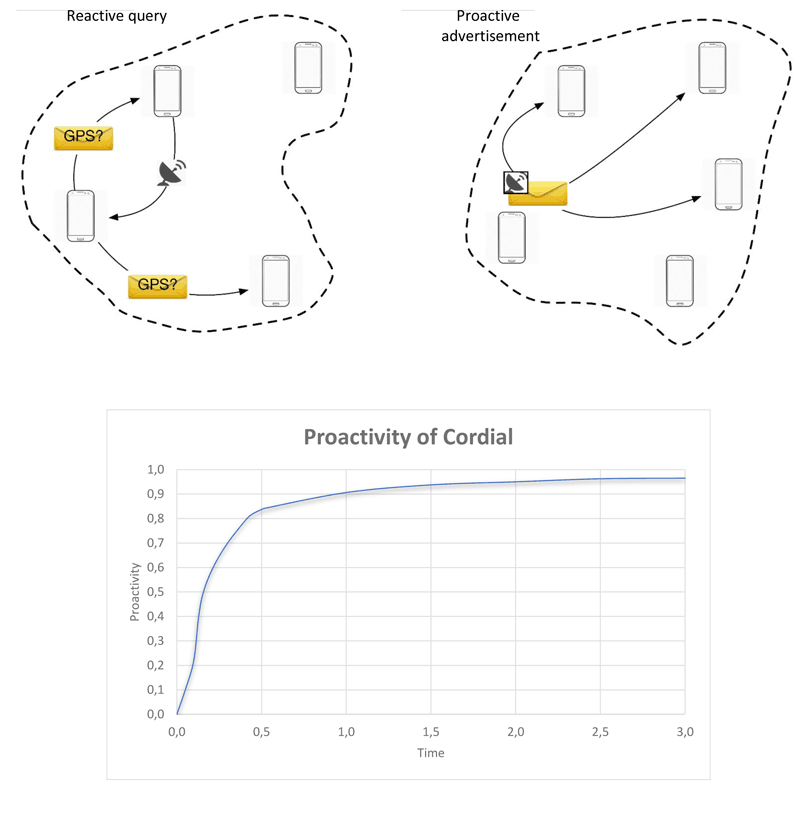by Stefano Chessa and Michele Girolami (ISTI-CNR)
The Wireless Network Laboratory at ISTI-CNR studies how to exploit mobility and sociality of people in a mobile social network in order to advertise and discover the services provided by devices. This problem is commonly referred to as service discovery. An efficient strategy for advertising to other devices about the existence of new or existing services is proposed alongside a strategy for discovering a specific service.
Mobile social networking is made up of two key-ingredients: people and the smart devices carried by them [1]. First, people follow a social rather than a random mobility pattern. People tend to spend time together with people who have similar interests [2]. Second, devices are designed with advanced hardware and software capabilities, and they can communicate among themselves based on short-range wireless interfaces, thus forming a mobile network. Indeed, they are equipped with different types of resources such as sensing units and several computational capabilities. Such resources can be seen as exploitable services that can be shared with other devices. When the service-oriented approach is applied in a mobile social context, common application problems have to be rethought for this new challenging perspective.
The goal of our research is to study how to exploit mobility and sociality of people in a mobile social network in order to advertise and discover the services provided by devices. This problem is commonly referred to as service discovery.
We investigate the service discovery problem, and in particular the possibility of advertising and discovering services offered by devices in the mobile social network. We propose an efficient strategy for advertising new or existing services to other devices and, at the same time, a strategy for discovering a specific service. The algorithm we have designed is referred to as CORDIAL (Collaborative Service Discovery Algorithm) alluding to the opportunities arising from people close to us.
CORDIAL adopts both a reactive and a proactive mechanism. The reactive mechanism is used to diffuse a service query and implements the query forwarding strategy. This strategy is executed by a device as soon as the user carrying it needs to access a specific service. Consider the following scenario where a user needs to tag a picture with GPS coordinates. The user’s device does not provide this functionality, but she can discover devices in proximity that do offer such a service. Once the user finds the required service, in this case the GPS, she can invoke it (see Figure 1).

Figure 1: The Reactive and Proactive strategies and Accuracy and Proactivity metrics.
The basic idea of the reactive phase is to select those devices in range with interests similar to the query sent by the user. Moreover, our strategy gives priority to those devices that are able to interact with other devices (e.g., strangers) that can potentially answer to the service query.
The proactive mechanism of CORDIAL is required to proactively diffuse queries not yet answered (namely the pending queries) and to advertise the existence of services. In this case, the goal is to maximise the diffusion of the messages (queries and service advertisements) and, at the same time, reduce message duplication.
The outcome of this research was the ability to reproduce mobile social networks by using real-world mobility traces. Such traces do a good job of reproducing human mobility in open outdoor environments such as a university campus or a city district. Among all the metrics analysed, we gave particular emphasis to the capacity of the discovery algorithm to store service advertisements of interest for the device, by avoiding the submission of queries (the proactivity metric). Moreover, we analysed the capacity of the algorithm to store only those service advertisements of interest for a device. Such a policy avoids storing off-topic advertisements (we measured such behaviour with the accuracy metric). CORDIAL also obtains optimal values of both metrics (proactivity and accuracy) when compared with other social-aware discovery strategies.
We thus investigated the possibility of exploiting, in an opportunistic fashion, the increasing number of resources offered by smart or low-power devices in mobile social networks. Future work includes the possibility of using CORDIAL in both participatory and opportunistic crowd sensing scenarios as well as using CORDIAL combined together with off-loading computing techniques.
References:
[1] M. Girolami, S. Chessa, A. Caruso: “On Service Discovery in Mobile Social Networks: Survey and Perspectives”, Computer Networks, 88, (2015):51-71, DOI 10.1016/j.comnet.2015.06.006
[2] M. McPherson, L. S. Lovin, J. M. Cook, “Birds of a Feather: Homophily in Social Networks”, Annual Review of Sociology, 27: 415–444, 2001.
Please contact:
Michele Girolami, ISTI-CNR, Italy











